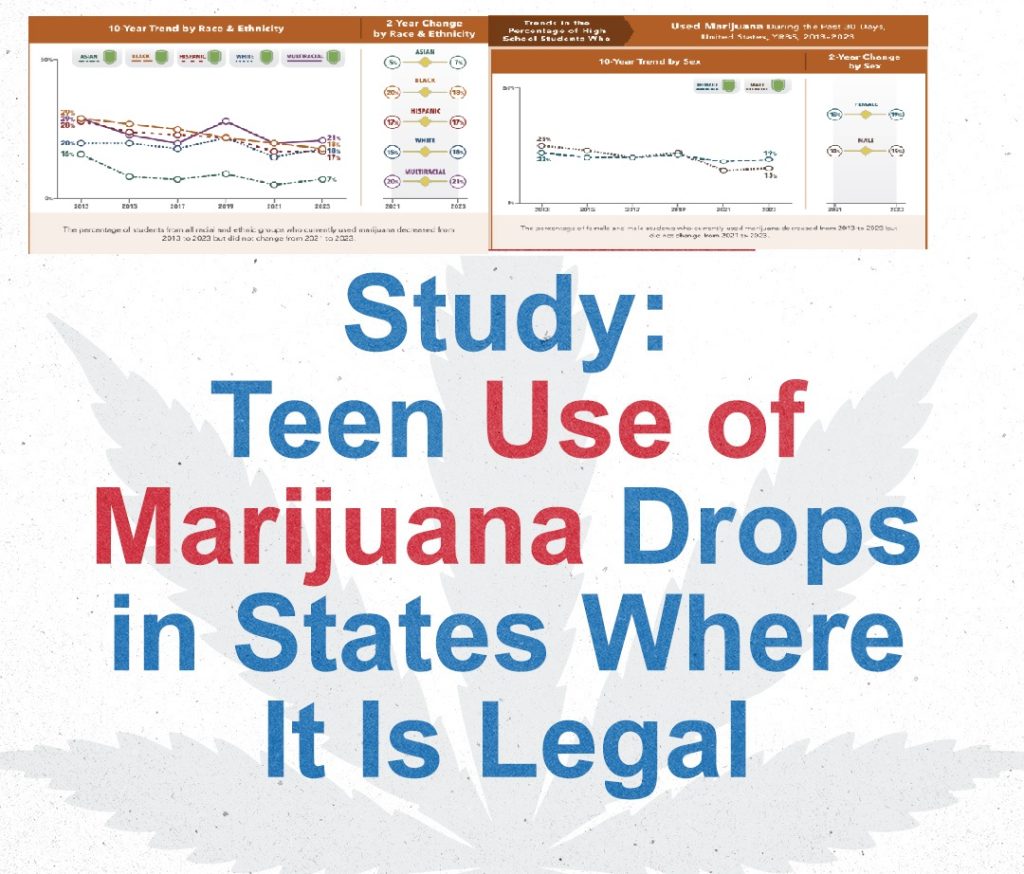CDC Data Highlights Sustained Decline in Youth Marijuana Use in Last Decade
4 min read
The percentage of high-schoolers nationwide using cannabis has declined significantly over the past ten years, according to newly released data provided by the Centers for Disease Control and Prevention.
According to the findings of agency’s latest report, Youth Risk Behavior Survey: Data Summary & Trends Report 2013-2023, “Ten-year trends are continuing to improve for some areas of adolescent health and well-being, including substance use.”
Specifically, the report finds that the percentage of high-schoolers nationally who identify as current consumers of cannabis fell 26 percent between 2013 and 2023.
The CDC data comes just days after the publication of the most recent National Survey on Drug Use and Health. That report, published by the US Department of Health and Human Services’ Substance Abuse Mental Health Services Administration, similarly identified a significant decline in cannabis use by young people. Specifically, it reported that the percentage of those ages 12 to 17 who reported having ever tried marijuana fell 18 percent from 2014 to 2023.
A recent federal report published by the Substance Abuse and Mental Health Services Administration (SAMHSA), for example, found that consumption among minors—defined as people 12 to 20 years of age—fell slightly in the past year. Despite methodological changes that make comparisons over time difficult, it also suggests that youth use has fallen significantly in the past decade.
The survey found that the percentage of young people aged 12 to 17 who’ve ever tried marijuana dropped 18 percent from 2014, when the first legal recreational cannabis sales in the U.S. launched, to 2023. Past-year and past-month rates among young people also declined during that time period.
Notably, male students showed a more marked drop in marijuana use over the past decade, with rates falling from 25 percent in 2013 to 15 percent in 2023. Among female students over the same time period, rates decreased from 22 percent to 19 percent.
Newly published results of a Centers for Disease Control and Prevention (CDC) survey show a decline in the proportion of high-school students reporting past-month marijuana use over the past decade, as dozens of states moved to legalize cannabis.
As of 2023, 17 percent of high-school students reported using marijuana within the past month, according to the newly released 2023 Youth Risk Behavior Survey. That’s down from 23 percent in 2013.
The federal survey is conducted every two years and focuses on substance use, sexual behavior, mental health, experiences of violence and suicidal thoughts and behaviors.
Though youth use rates have ticked up and down by a few percentage points from survey to survey within the 10-year timespan covered by the CDC report, the overall trend is that past-month use among high-school students has declined since 2013, the data show.
Notably, male students showed a more marked drop in marijuana use over the past decade, with rates falling from 25 percent in 2013 to 15 percent in 2023. Among female students over the same time period, rates decreased from 22 percent to 19 percent.
“There have been promising declines in high school students’ use of substances,” the report notes. “All substance use behaviors included in this report decreased during the years that trends were measured. Since 2013, the percentage of students who currently drank alcohol, currently used marijuana, or had ever used select illicit drugs decreased.”
The decline in teen cannabis use is contrary to the fears of legalization opponents who have continually warned that ending prohibition of marijuana for adults would trigger large increases in youth consumption. Yet, past-month youth marijuana use rates fell across all surveyed racial groups during the past 10 years, the CDC data show.
Over the most recent two-year period—from 2021 to 2023—high-school marijuana use rates rose slightly, from 16 percent to 17 percent among all surveyed students, though CDC reported the difference as “no change” in the new report.
Commenting on the federal survey data, NORML Deputy Director Paul Armentano said, “Sensational claims that adult-use legalization laws are linked with greater marijuana use by teens are simply not backed by reliable data. These government findings ought to reassure lawmakers that cannabis access can be legally regulated in a manner that is safe, effective, and that does not inadvertently impact young people’s habits.”
The report also finds that a far greater percentage of high-schoolers identify as current alcohol consumers than identify as current cannabis consumers….“There have been promising declines in high school students’ use of substances,” the report notes. “All substance use behaviors included in this report decreased during the years that trends were measured. Since 2013, the percentage of students who currently drank alcohol, currently used marijuana, or had ever used select illicit drugs decreased.”
Data published in April in the journal JAMA Psychiatry similarly determined that neither the passage of adult-use marijuana legalization laws nor the advent of retail cannabis sales is associated with increased marijuana use by adolescents. Further, compliance check data from California, Colorado, Nevada, and other legal marijuana states show that licensed marijuana retailers do not sell products to underage patrons.
Writing in a syndicated op-ed last year, NORML’s Armentano acknowledged: “States’ real-world experience with marijuana legalization affirms that these policies can be implemented in a way that provides regulated access for adults while simultaneously limiting youth access and misuse. … To date, not a single state that has implemented legalization has reversed course. That’s because these policies are working largely as politicians and voters intended — and because they are preferable to marijuana prohibition.”
Data origin at CDC, NORML




